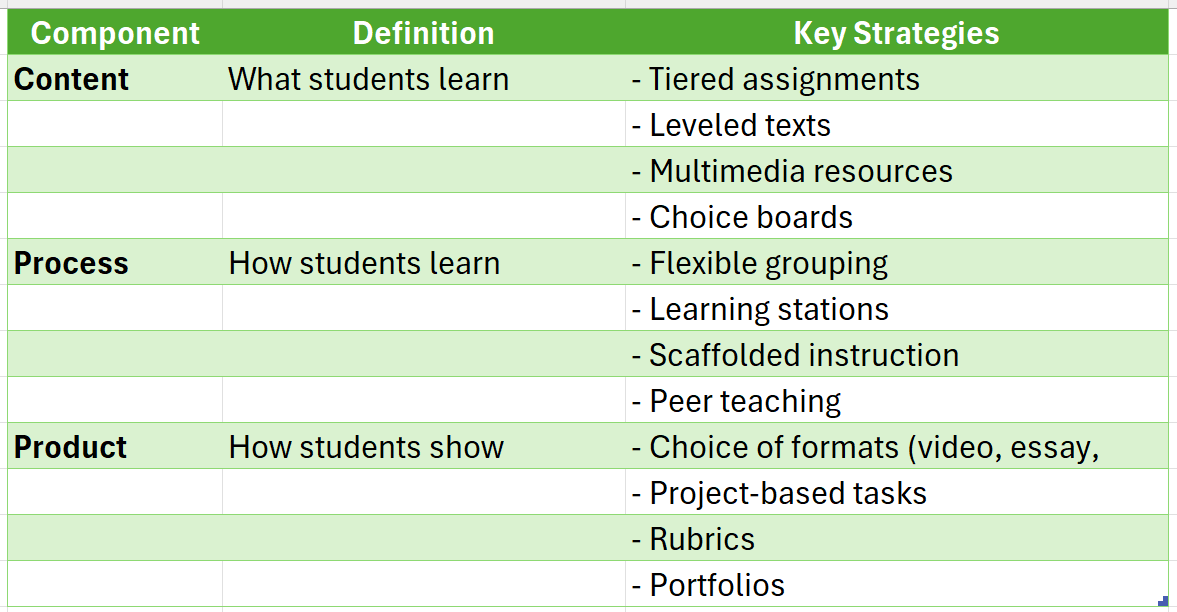
Creating differentiated lesson plans is essential for meeting the diverse needs of learners in today’s classrooms. Every student comes with unique backgrounds, abilities, and interests. By tailoring lessons, educators can ensure that all students engage meaningfully with the curriculum, fostering a love for learning and improving outcomes.
Why Differentiate?
- Engagement: Students are more likely to participate when lessons resonate with their experiences.
- Achievement: Differentiated lesson plans help all students reach their potential, regardless of their starting point.
- Inclusivity: These plans create a welcoming environment for every learner, including those with special needs or language barriers.
Incorporating differentiated lesson plans is not just beneficial; it’s necessary for high-quality curriculum development. As a curriculum designer, especially in remote jobs, understanding how to create these plans can set you apart. It allows you to design lessons that cater to various learning styles, ensuring that every student has the opportunity to succeed.
Affordable, accredited education—Start now!
What Are the Key Components of Effective Differentiated Lesson Plans?
Creating differentiated lesson plans is essential for meeting the diverse needs of learners in today’s classrooms. When teachers tailor their lessons, they ensure that every student, regardless of their learning style or ability, can engage with the material effectively. This approach not only boosts understanding but also fosters a love for learning.
Understanding Learner Profiles
To create effective differentiated lesson plans, start by understanding your students. Gather information about their interests, strengths, and areas for improvement. This insight helps you design lessons that resonate with each learner, making your curriculum more engaging and relevant.
Flexible Grouping Strategies
Utilize flexible grouping strategies to encourage collaboration. Mix students based on their skills or interests, allowing them to learn from one another. This not only enhances social skills but also promotes a deeper understanding of the material. Remember, effective differentiated lesson plans are adaptable and responsive to student needs.
How to Assess the Needs of Diverse Learners?
Creating differentiated lesson plans for diverse learners is essential because every student has unique strengths and challenges. By tailoring your approach, you can ensure that all students engage with the material and achieve their potential. This not only enhances learning but also fosters a more inclusive classroom environment.
Understand Individual Learning Styles
To create effective differentiated lesson plans, start by assessing the learning styles of your students. Some may thrive with visual aids, while others prefer hands-on activities. Understanding these preferences helps you design high-quality curriculum that resonates with everyone.
Gather Feedback and Data
Collecting feedback from students can provide valuable insights. Use surveys or informal discussions to learn what works for them. Additionally, analyze performance data to identify areas where students struggle. This information is crucial for curriculum designer remote jobs, as it helps create targeted lesson plans that meet diverse needs.
Strategies for Differentiating Content, Process, and Product

Creating differentiated lesson plans is essential for meeting the diverse needs of learners in today’s classrooms. Every student has unique strengths, interests, and challenges, making it crucial for educators to tailor their teaching approaches. This not only enhances engagement but also fosters a love for learning, which is vital for academic success.
Understand Your Learners
To create effective differentiated lesson plans, start by understanding your students. Assess their learning styles, interests, and readiness levels. This insight will guide you in designing high-quality curriculum that resonates with each learner, ensuring they feel valued and understood.
Differentiate Content, Process, and Product
- Content: Offer materials at varying levels of complexity. For example, provide texts at different reading levels or use videos for visual learners.
- Process: Allow students to choose how they engage with the material. Some might prefer group work, while others thrive in independent study.
- Product: Let students demonstrate their understanding in various ways, like presentations, projects, or written reports. This flexibility encourages creativity and ownership of their learning.
Engaging All Learners: Techniques for Active Participation
Creating differentiated lesson plans is essential for engaging all learners, especially in diverse classrooms. When teachers tailor their lessons to meet various needs, every student can participate actively and feel valued. This approach not only enhances learning but also fosters a sense of belonging among students.
Understand Your Students
To create effective differentiated lesson plans, start by knowing your students. Consider their interests, learning styles, and challenges. This insight helps you design activities that resonate with each learner.
Use Varied Teaching Methods
Incorporate different teaching methods to cater to diverse learners. For example:
- Visual aids for visual learners
- Group discussions for social learners
- Hands-on activities for kinesthetic learners
Foster a Collaborative Environment
Encourage teamwork and collaboration. Group projects allow students to learn from each other, promoting engagement and understanding. This approach not only enriches the learning experience but also prepares students for real-world interactions. By implementing these techniques, you can create high-quality curriculum that supports all learners, making your classroom a vibrant space for growth.
How to Use Technology to Enhance Differentiated Lesson Plans?
Creating differentiated lesson plans is essential for meeting the needs of diverse learners. By tailoring lessons to various learning styles and abilities, educators can foster an inclusive environment where every student can thrive. But how can technology play a role in enhancing these lesson plans?
Leverage Online Resources
- Interactive Tools: Use platforms like Kahoot or Quizlet to create engaging quizzes that cater to different skill levels.
- Video Content: Incorporate educational videos that explain concepts in multiple ways, making learning accessible for visual and auditory learners.
Foster Collaboration
- Group Projects: Utilize tools like Google Classroom for collaborative projects, allowing students to work together and learn from each other.
- Peer Feedback: Encourage students to give feedback on each other’s work using online forums, promoting a sense of community.
By integrating technology into differentiated lesson plans, curriculum designers can create high-quality curriculum that resonates with all students. This approach not only enhances learning but also prepares students for a tech-savvy world.
Creating a Flexible Classroom Environment for Diverse Learners
Creating differentiated lesson plans is vital for addressing the needs of diverse learners. Each student has unique strengths and challenges, and a flexible classroom environment fosters their success. Tailoring your approach ensures that all students engage effectively with the curriculum.
Understand Your Students
Begin by understanding your students’ interests, learning styles, and specific needs. This insight will help you design a high-quality curriculum that resonates with each learner.
Incorporate Varied Teaching Methods
Use a mix of teaching strategies to accommodate different learning preferences. For instance:
- Visual aids for visual learners
- Group discussions for social learners
- Hands-on activities for kinesthetic learners
This variety keeps lessons engaging and enhances comprehension for all students.
Assess and Adapt
Regularly assess student progress and be prepared to adapt your lesson plans. This flexibility is especially important in remote learning environments, where curriculum designer remote jobs are increasingly prevalent. Continuously refining your approach ensures that every student receives the necessary support.
Affordable, accredited education—Start now!
Collaborating with Colleagues: Sharing Best Practices in Differentiation
Creating differentiated lesson plans for diverse learners is essential in today’s classrooms. When teachers collaborate, they can share insights and strategies that enhance their teaching methods. This teamwork not only benefits students but also enriches the educators’ experience, making learning more effective and enjoyable.
The Power of Teamwork
When teachers come together, they can brainstorm ideas for high-quality curriculum that meets the needs of all students. Sharing best practices allows educators to learn from each other’s successes and challenges, leading to more effective differentiated lesson plans.
Key Benefits of Collaboration
- Diverse Perspectives: Different teachers bring unique insights that can spark new ideas.
- Resource Sharing: Collaborating helps in pooling resources, making it easier to create engaging materials.
- Support System: Having colleagues to discuss challenges with can provide emotional and professional support, making the teaching journey smoother.
How Can Degreesonline.education Support Your Differentiation Efforts?
Creating differentiated lesson plans is essential for meeting the diverse needs of learners in today’s classrooms. Every student has unique strengths, interests, and challenges, making it crucial to tailor lessons that engage and support all learners. This approach not only enhances understanding but also fosters a love for learning.
At Degreesonline.education, we understand the importance of high-quality curriculum that caters to varied learning styles. Here’s how we can help you create effective differentiated lesson plans:
1. Access to Resources
- Diverse Materials: We provide a range of teaching resources that can be adapted for different learning levels.
- Flexible Formats: Choose from videos, articles, and interactive activities to suit your students’ preferences.
2. Professional Development
- Training Opportunities: Our platform offers workshops on effective differentiation strategies.
- Curriculum Designer Remote Jobs: Join our team to collaborate with experts in creating engaging lesson plans that meet diverse needs.
By utilizing these resources, you can create lesson plans that not only engage students but also promote a more inclusive learning environment.
Evaluating the Effectiveness of Your Differentiated Lesson Plans
Creating differentiated lesson plans is essential for addressing the needs of diverse learners. By tailoring your teaching strategies, you help each student engage with the material in a way that aligns with their unique learning style, enhancing understanding and promoting inclusivity in the classroom.
Key Indicators of Success
- Student Engagement: Are students actively participating?
- Assessment Results: Are grades improving?
- Feedback: What do students say about their learning experience?
To effectively evaluate your differentiated lesson plans, gather student feedback to identify what works and what doesn’t. Use formative assessments to monitor understanding during lessons, allowing you to adapt your teaching as needed to support all learners.
Continuous Improvement
Creating a high-quality curriculum is an ongoing journey. Regularly revisiting and refining your lesson plans keeps you responsive to your students’ needs. As a curriculum designer, whether in remote jobs or traditional settings, your ability to adapt is crucial for fostering a successful learning environment.
Affordable, accredited education—Start now!
FAQs
1. What is a differentiated lesson plan?
A differentiated lesson plan is designed to meet the diverse learning needs, interests, and abilities of all students in the classroom.
2. Why is differentiation important in teaching?
It ensures that every student is challenged at their level and can access the content in a way that works best for them.
3. How do teachers differentiate a lesson?
Teachers can adjust the content, process, product, or learning environment based on student readiness, learning style, or interests.
4. What are examples of differentiation in a lesson?
Examples include offering reading materials at different levels, giving students choice in projects, or using small-group instruction.
5. Is differentiation the same as individualized instruction?
Not exactly. Differentiation addresses group needs within a classroom, while individualized instruction is tailored for one specific student.
6. How can I assess learning in a differentiated classroom?
Use a variety of assessments—like rubrics, observations, and student self-assessments—to evaluate progress based on individual goals.




